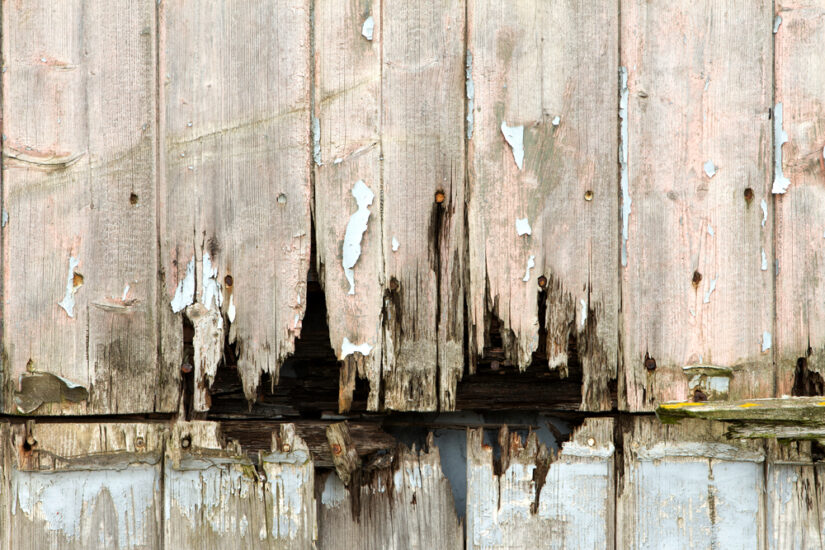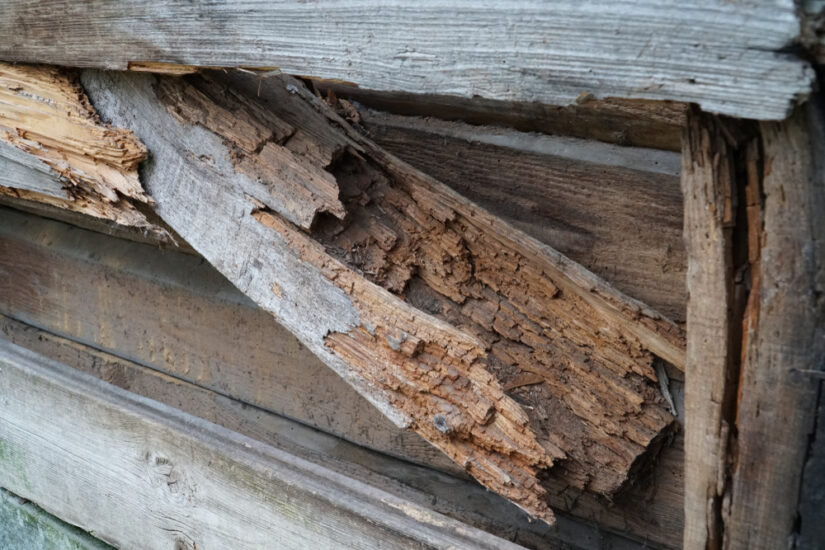
Dry rot is a common issue that affects many homes, often developing in areas that are hidden from view. It thrives in damp, poorly ventilated spaces, leading to the deterioration of wooden structures. The attic and basement are particularly prone to dry rot, as these areas often suffer from high humidity and inadequate air circulation.
Kitchens and bathrooms are also at risk due to frequent exposure to water. Leaks and condensation can create moisture-rich environments, encouraging the growth of dry rot. Additionally, the structural wooden beams behind walls and under floors can be affected, so inspections are crucial to identifying dry rot in your home.
Understanding Dry Rot
Causes of Dry Rot
Dry rot is primarily caused by moisture, providing a fertile fungi environment. The most common fungi responsible is Serpula lacrymans, thriving in wood with a moisture content of around 20-30%.
Poor ventilation, plumbing leaks, and high humidity levels can also contribute to conditions favorable for rot. Areas like basements, attics, and spaces beneath floors often accumulate moisture unnoticed, making them susceptible. It’s crucial to promptly address water leaks and improve ventilation to prevent the spread.
Damage occurs as the fungi digest the cellulose in wood, weakening it structurally. Monitoring these conditions is essential to preventing dry rot.
Early Detection and Identification
Early detection of dry rot can save homeowners from significant repair costs. Signs include a strong, earthy odor and the appearance of a cotton-like substance on wood surfaces. Sometimes, cracked wood with shrunken pockets can indicate an issue.
A careful inspection might reveal orange or rust-colored spore dust, typically a clear sign. Wood that is easily crumbled or brittle to the touch also suggests decay. Special inspection tools can measure moisture levels, providing clarity on whether conditions might support fungal growth.
Preventative measures such as regular inspections and maintaining ideal humidity levels can help in early detection and management. Recognizing these early symptoms is critical to preserving the structural integrity of any home.

Common Areas for Dry Rot Development in Homes
Attic and Roof Spaces
The attic and roof spaces are susceptible to dry rot due to moisture infiltration. This can occur from a leaky roof, poor ventilation, or condensation build-up. Wooden beams and supports in these areas are vulnerable. Insulation that traps moisture further aggravates the issue.
Regular inspection and prompt repair of roof leaks can mitigate these risks. Ventilation improvements, such as adding exhaust fans or vents, help to reduce humidity levels. Keeping gutters clear and ensuring proper roof drainage minimizes moisture exposure.
Floors and Floor Joists
Floors are prone to dry rot, particularly if the ground beneath is damp or improperly protected. Wooden floor joists suffer the most when moisture seeps in. Basements and crawl spaces often harbor conditions conducive to dry rot.
Moisture barriers or vapor barriers can be installed to prevent ground moisture from affecting the floors. Checking for leaks in plumbing running beneath the floor can also prevent moisture accumulation.
Raising floors slightly above ground level and ensuring good air circulation around them can reduce risk. Regular inspections are advised to identify any early signs of damage.
External Walls and Cladding
External walls and cladding can be affected by dry rot if they are not adequately protected from rainwater. Faulty gutters, downspouts, or flashing may direct water onto these surfaces. Moisture trapped in cavities or due to insufficient airflow can accelerate rot.
Using waterproof materials or coatings on walls helps protect these surfaces. Ensuring gutters and downspouts are clean and intact prevents water from spilling onto walls. Venting and drainage systems should be checked regularly to avoid moisture build-up.
Sealants and caulking play a crucial role in keeping external surfaces water-tight. Inspecting and repairing damaged cladding keeps moisture from penetrating beneath the surface.
Windows and Door Frames
Windows and door frames are common sites for dry rot due to frequent exposure to rain and condensation. Poorly sealed frames allow moisture to penetrate the wood. Insufficient ventilation increases humidity levels, leading to damage.
Using rot-resistant wood or treated timber for frames reduces the likelihood of rot. Regular sealing and painting maintain the integrity of the wood and provide an additional moisture barrier. Installing weather stripping helps prevent water ingress during storms.
Regular maintenance, including cleaning and checking for soft spots, keeps windows and doors in good condition. Replacing damaged wood promptly prevents further decay.
Plumbing Areas and Bathrooms
Plumbing areas, especially in bathrooms, face unique challenges in dry rot management. Leaky pipes or fixtures often lead to excess moisture in the immediate vicinity. Shower seals and tub edges are frequent culprits.
Using moisture-resistant backing materials, like cement board, instead of traditional drywall can help. Ensure silicone waterproof seals around fixtures are intact and replace them when they deteriorate.
Ventilation fans should be installed and used to limit humidity build-up. Monitoring for leaks near plumbing joints and around bathroom fixtures ensures prompt repair and reduces rot risk. Regularly inspecting or replacing faulty plumbing components can prevent hidden moisture issues that lead to dry rot.
Preventative Measures for Dry Rot
Improving Ventilation
Effective ventilation is essential to reduce the risk of dry rot. Homes should have sufficient airflow in areas like basements, crawl spaces, and attics. Installing vents and ensuring air passages are unobstructed can help maintain the necessary air circulation.
Attic fans or ventilators can be practical solutions to enhance airflow. These help in removing moisture-laden air, reducing the likelihood of dampness leading to dry rot, particularly in less accessible areas. Regular inspections of vents and fans ensure they are free of blockages, sustaining their efficiency.
Moisture Control
Controlling moisture is fundamental in preventing dry rot. It’s important to identify sources of water ingress, such as leaks in roofs, walls, or plumbing systems. Immediate repairs are vital to prevent continuous exposure of timber to moisture.
Sealing gaps and using waterproof coatings on surfaces can further protect the structure. Installing dehumidifiers can significantly reduce ambient moisture levels, especially in vulnerable spaces like basements and crawl spaces. Regular monitoring helps keep moisture at safe levels, avoiding the conditions favorable for fungal growth.
Professional Dry Rot Assessment and Repair
Choosing a Professional Service
Selecting the right dry rot repair services is crucial. Homeowners should check for certifications and experience in dealing with wood decay. Reading reviews and asking for referrals can help in finding a reputable service.
A good service will provide an initial assessment to determine the extent of the damage. Professionals should offer a clear, detailed estimate covering inspection, labor, materials, and any follow-up treatments. Ensuring they use safe, effective materials and processes is vital. It’s advisable to inquire about warranties or guarantees for the repairs.
Repair Process
The repair process begins with an in-depth inspection to locate all affected areas. This is followed by removing decayed wood and replacing it with treated timber. Applying fungicidal treatments prevents future rot.
Professionals often use advanced techniques and tools to ensure thorough removal and repair. They may use moisture meters to ensure the underlying issues are addressed. After repairing structural damage, ventilation improvements or moisture control solutions might be advisable to prevent recurrence. It’s essential to follow professional advice and adhere to any maintenance tips provided.